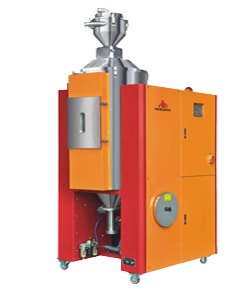What is the difference between a dehumidifying dryer and an ordinary dryer?
Dehumidifying dryers are generally used in industrial production to dehumidify and dry raw materials with strong hygroscopicity to ensure high product forming rates. In the past, companies used traditional hot air blowers. If they encounter wet weather, the hot air blowers can hardly complete the drying purpose. The desiccant dryer came into being to improve the disadvantages of the hot air blower. So what is the difference between a dehumidifying dryer and an ordinary dryer?
1. Traditional hot air blower
In order to evaporate the moisture in the material, the traditional hot air blower will use the hot air heated by electric heating to dry the material at high temperature. However, due to weather factors, dry weather and humid weather, the moisture content in the air will be different, and the drying effect will also be different. In traditional hot air blowers, electric heating must first heat the incoming air. If the weather is too humid and the incoming air contains high moisture, it is difficult for the material to dry.
2. Dehumidification dryer
The dehumidification dryer effectively improves the shortcomings of ordinary dryers. It first draws in ambient air to remove moisture in the air under low dew point, and then heats the dried air to the dryer to dehumidify and dry the material. The work efficiency is greatly improved, the drying time is reduced, and the drying effect is better.
The air pipeline of the desiccant dryer adopts a closed circulation system, which can not be affected by the external weather, and the material can be dried well regardless of whether it is dry or humid. The filter installed in the desiccant dryer can prevent dust leakage from causing pollution in the factory and keep the air environment clean.
|
 +8613669807274
+8613669807274
 +8613669807274
+8613669807274 wto-btb@wto-btb.com
wto-btb@wto-btb.com Tel: +8613669807274
Tel: +8613669807274 SMS: +8613669807274
SMS: +8613669807274